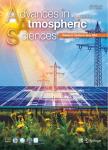Aerosol Optical Properties and Its Radiative Forcing over Yulin, China in 2001 and 2002
Aerosol Optical Properties and Its Radiative Forcing over Yulin, China in 2001 and 2002作者机构:Key Laboratory of Atmospheric ChemistryCentre for Atmosphere Watch and ServicesChinese Academy of Meteorological Sciences China Meteorological AdministrationBeijing 100081 Laboratoire Inter-Universitaire des Systmes AtmosphriquesUniversit Paris Ⅶ/Paris Ⅻ94010 Crteil Cedex France Centre National de la Recherche ScientifiqueMeto-France/CNRM/GMEI/MNPCA31057ToulouseFrance State Key Laboratory of Numerical Modeling for Atmospheric Sciences and Geophysical Fluid DynamicsInstitute of Atmospheric PhysicsChinese Academy of SciencesBeijing 100029
出 版 物:《Advances in Atmospheric Sciences》 (大气科学进展(英文版))
年 卷 期:2009年第26卷第3期
页 面:564-576页
核心收录:
学科分类:07[理学] 070601[理学-气象学] 0706[理学-大气科学] 0816[工学-测绘科学与技术] 0825[工学-航空宇航科学与技术]
基 金:supported by grants from the National Key Project of Basic Research (2006CB403702 and 2006CB403701) the CAMS Basis Research Project and National Natural Science Foundation of China under Grant No. 40405001
主 题:aerosol optical properties aerosol radiative forcing Mu Us desert China
摘 要:The aerosol optical properties and direct radiative forcing over the Mu Us desert of northern China, acquired through a CE318 sunphotometer of the ground-based Aerosol Robotic Network (AERONET), are analyzed. The seasonal variations in the aerosol optical properties are examined. The effect of meteorological elements (pressure, temperature, water vapor pressure, relative humidity and wind speed) on the aerosol optical properties is also studied. Then, the sources and optical properties under two different cases, a dust event and a pollution event, are compared. The results show that the high aerosol optical depth (AOD) found in Yulin was mostly attributed to the occurrence of dust events in spring from the Mu Us desert and deserts of West China and Mongolia, as well as the impacts of anthropogenic pollutant particles from the middle part of China in the other seasons. The seasonal variation and the probability distribution of the radiative forcing and the radiative forcing efficiency at the surface and the top of the atmosphere are analyzed and regressed using the linear and Gaussian regression methods.



